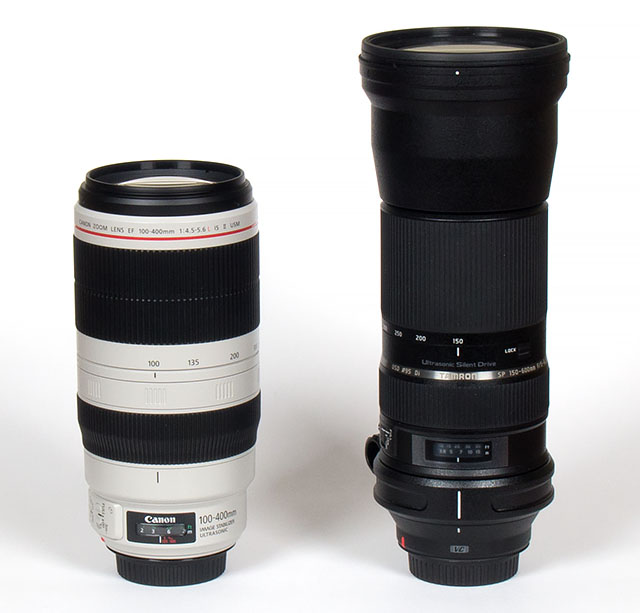|
Canon EF 100-400mm f/4.5-5.6 USM L IS II - Full Format Review / Test Report |
|
Lens Reviews -
Canon EOS (Full Format)
|
|
Page 1 of 3
Review by Klaus Schroiff, published December 2014

Introduction
Over the recent years, it became almost a bit of a running gag when one of the various rumor sites stated once more that "the refresh of the Canon EF 100-400mm f/4.5-5.6 USM L IS is really imminent now"! Well, it wasn't ... till the end of 2014. To be fair, other than the diffuse feeling that something has to happen, there wasn't really too much pressure for Canon here anyway. Quality-wise, the Canon EF 100-400mm f/4.5-5.6 USM L IS was always at the top of its species and the only really dated aspect was the IS (image stabilizer) which is just good enough for 2 extra f-stops. But yeah - here it is: the Canon EF 100-400mm f/4.5-5.6 USM L IS II. Thus enjoy finally! :-)

The lens has an excellent build quality based on a weather-sealed metal body - it shows no wobbling whatsoever even when zooming out to 400mm. One of the more obvious changes is the rotation-type zoom mechanism. Conversely, the mk I relied on a dated push-pull mechanism which probably wasn't really a love affair for most users. On the mk II, it remains possible to increase the friction of the zoom mechanism thus avoiding zoom creeping. Needless to say, the Canon lens has an internal focusing mechanism resulting in a non-rotating front element. The focusing and zoom action is pretty smooth. A newly designed, barrel-shaped lens hood with side window (for using a polarizer) is also part of the package. If anything we might criticize the comparatively small mount plate of the dedicated (detachable) tripod mount.
 Possibly the most important new feature is the updated IS. It can provide an equivalent "gain" of 4 f-stops (make it a little less in the real life as always). It now supports two IS modes as well as tripod-detection thus the IS doesn't "freak out" anymore by the lack of movements. A less obvious change is the new Air Sphere Coating (ASC) which is supposed to reduce backlit flaring and ghosting and a fluorine coatings on the front and rear lens surfaces for minimizing smears and fingerprints. As far as the optics is concerned, it is also worth mentioning that it continued to take advantage of a so-called floating focusing system for an optimized close-focus performance.
The lens features an improved ring-type USM drive resulting in extremely fast and virtually silent AF operations. Full-time manual focusing is possible in one-shot AF mode. If you prefer to tame AF hunting, you can also limit the focus range to 3m-infinity instead of the full range.
So that's all promising, isn't it ? However, it is necessary to point out that the things have changed in the super tele zoom lens arena lately. A 100-400mm range isn't something special anymore. Both Tamron and now also Sigma are offering competing lenses with no less than 600mm at the long end - for the same price point or less. Regarding the lesser reach, the Canon lens should at least provide a better image quality. Well, we'll see.
Here's a product image comparison with the Tamron 150-600mm f/4.5-6.3 SP VC - so the Canon lens can at least claim an advantage in terms of size (and weight).
Possibly the most important new feature is the updated IS. It can provide an equivalent "gain" of 4 f-stops (make it a little less in the real life as always). It now supports two IS modes as well as tripod-detection thus the IS doesn't "freak out" anymore by the lack of movements. A less obvious change is the new Air Sphere Coating (ASC) which is supposed to reduce backlit flaring and ghosting and a fluorine coatings on the front and rear lens surfaces for minimizing smears and fingerprints. As far as the optics is concerned, it is also worth mentioning that it continued to take advantage of a so-called floating focusing system for an optimized close-focus performance.
The lens features an improved ring-type USM drive resulting in extremely fast and virtually silent AF operations. Full-time manual focusing is possible in one-shot AF mode. If you prefer to tame AF hunting, you can also limit the focus range to 3m-infinity instead of the full range.
So that's all promising, isn't it ? However, it is necessary to point out that the things have changed in the super tele zoom lens arena lately. A 100-400mm range isn't something special anymore. Both Tamron and now also Sigma are offering competing lenses with no less than 600mm at the long end - for the same price point or less. Regarding the lesser reach, the Canon lens should at least provide a better image quality. Well, we'll see.
Here's a product image comparison with the Tamron 150-600mm f/4.5-6.3 SP VC - so the Canon lens can at least claim an advantage in terms of size (and weight).

| Specifications |
|---|
| Optical construction | 21 elements in 16 groups inc. 1x CaF2 + 1xSUD elements |
| Number of aperture blades | 9 (circular) |
| min. focus distance | 0.98m (max. magnification ratio 1:3.2) |
| Dimensions | 193x94mm |
| Weight | 1570g |
| Filter size | 77mm (non-rotating) |
| Hood | barrel-shaped, bayonet mount, supplied |
| Other features |
detachable tripod mount
compatible to the Canon EF 1.4x and 2x converters
IS
weather sealing
ASC (Air Sphere Coating)
zoom torque adjustment ring
|
|